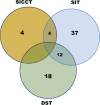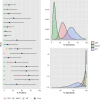Comparative analysis of tuberculin and defined antigen skin tests for detection of bovine tuberculosis in buffaloes (Bubalus bubalis) in Haryana state, India
- PMID: 38395846
- PMCID: PMC11308649
- DOI: 10.1186/s12917-024-03913-3
Comparative analysis of tuberculin and defined antigen skin tests for detection of bovine tuberculosis in buffaloes (Bubalus bubalis) in Haryana state, India
Abstract
Background: Bovine tuberculosis (bTB) is a chronic disease that results from infection with any member of the Mycobacterium tuberculosis complex. Infected animals are typically diagnosed with tuberculin-based intradermal skin tests according to World Organization of Animal Health which are presently in use. However, tuberculin is not suitable for use in BCG-vaccinated animals due to a high rate of false-positive reactions. Peptide-based defined skin test (DST) antigens have been identified using antigens (ESAT-6, CFP-10 and Rv3615c) which are absent from BCG, but their performance in buffaloes remains unknown. To assess the comparative performance of DST with the tuberculin-based single intradermal test (SIT) and the single intradermal comparative cervical test (SICCT), we screened 543 female buffaloes from 49 organized dairy farms in two districts of Haryana state in India.
Results: We found that 37 (7%), 4 (1%) and 18 (3%) buffaloes were reactors with the SIT, SICCT and DST tests, respectively. Of the 37 SIT reactors, four were positive with SICCT and 12 were positive with the DST. The results show that none of the animals tested positive with all three tests, and 6 DST positive animals were SIT negative. Together, a total of 43 animals were reactors with SIT, DST, or both, and the two assays showed moderate agreement (Cohen's Kappa 0.41; 95% Confidence Interval (CI): 0.23, 0.59). In contrast, only slight agreement (Cohen's Kappa 0.18; 95% CI: 0.02, 0.34) was observed between SIT and SICCT. Using a Bayesian latent class model, we estimated test specificities of 96.5% (95% CI, 92-99%), 99.7% (95% CI: 98-100%) and 99.0% (95% CI: 97-100%) for SIT, SICCT and DST, respectively, but considerably lower sensitivities of 58% (95% CI: 35-87%), 9% (95% CI: 3-21%), and 34% (95% CI: 18-55%) albeit with broad and overlapping credible intervals.
Conclusion: Taken together, our investigation suggests that DST has a test specificity comparable with SICCT, and sensitivity intermediate between SIT and SICCT for the identification of buffaloes suspected of tuberculosis. Our study highlights an urgent need for future well-powered trials with detailed necropsy, with immunological and microbiological profiling of reactor and non-reactor animals to better define the underlying factors for the large observed discrepancies in assay performance, particularly between SIT and SICCT.
Keywords: Bovine tuberculosis; Buffaloes; DST; Haryana; India; SICCT; SIT.
© 2024. The Author(s).
Conflict of interest statement
The authors declare no competing interests.
Figures



Similar articles
-
A Defined Antigen Skin Test for Diagnosis of Bovine Tuberculosis in Domestic Water Buffaloes (Bubalus bubalis).Front Vet Sci. 2021 Aug 16;8:669898. doi: 10.3389/fvets.2021.669898. eCollection 2021. Front Vet Sci. 2021. PMID: 34490387 Free PMC article.
-
Field evaluation of specific mycobacterial protein-based skin test for the differentiation of Mycobacterium bovis-infected and Bacillus Calmette Guerin-vaccinated crossbred cattle in Ethiopia.Transbound Emerg Dis. 2022 Jul;69(4):e1-e9. doi: 10.1111/tbed.14252. Epub 2021 Aug 19. Transbound Emerg Dis. 2022. PMID: 34331511 Free PMC article.
-
Field evaluation of the tuberculin skin test for the detection of Mycobacterium tuberculosis complex infection in communal goats (Capra hircus) in KwaZulu-Natal, South Africa.Vet Immunol Immunopathol. 2022 Oct;252:110486. doi: 10.1016/j.vetimm.2022.110486. Epub 2022 Sep 13. Vet Immunol Immunopathol. 2022. PMID: 36116328
-
Meta-analyses of the sensitivity and specificity of ante-mortem and post-mortem diagnostic tests for bovine tuberculosis in the UK and Ireland.Prev Vet Med. 2018 May 1;153:94-107. doi: 10.1016/j.prevetmed.2017.02.017. Epub 2017 Mar 6. Prev Vet Med. 2018. PMID: 28347519
-
Ante mortem diagnosis of tuberculosis in cattle: a review of the tuberculin tests, gamma-interferon assay and other ancillary diagnostic techniques.Res Vet Sci. 2006 Oct;81(2):190-210. doi: 10.1016/j.rvsc.2005.11.005. Epub 2006 Mar 2. Res Vet Sci. 2006. PMID: 16513150 Review.
Cited by
-
Comparative performance and age dependence of tuberculin and defined antigen bovine tuberculosis skin tests assessed with Bayesian latent class analysis.Sci Rep. 2025 Jun 5;15(1):19728. doi: 10.1038/s41598-025-05223-6. Sci Rep. 2025. PMID: 40473835 Free PMC article.
References
-
- World Organization of Animal Health. Manual of standards for diagnostic tests and vaccines. In: Bovine tuberculosis. Paris: WOAH; 2008. p. 683–97.
MeSH terms
Substances
Grants and funding
- OPP1176950/GATES/Bill & Melinda Gates Foundation/United States
- OPP1176950/GATES/Bill & Melinda Gates Foundation/United States
- OPP1176950/GATES/Bill & Melinda Gates Foundation/United States
- OPP1176950/GATES/Bill & Melinda Gates Foundation/United States
- OPP1176950/GATES/Bill & Melinda Gates Foundation/United States
LinkOut - more resources
Full Text Sources
Miscellaneous

